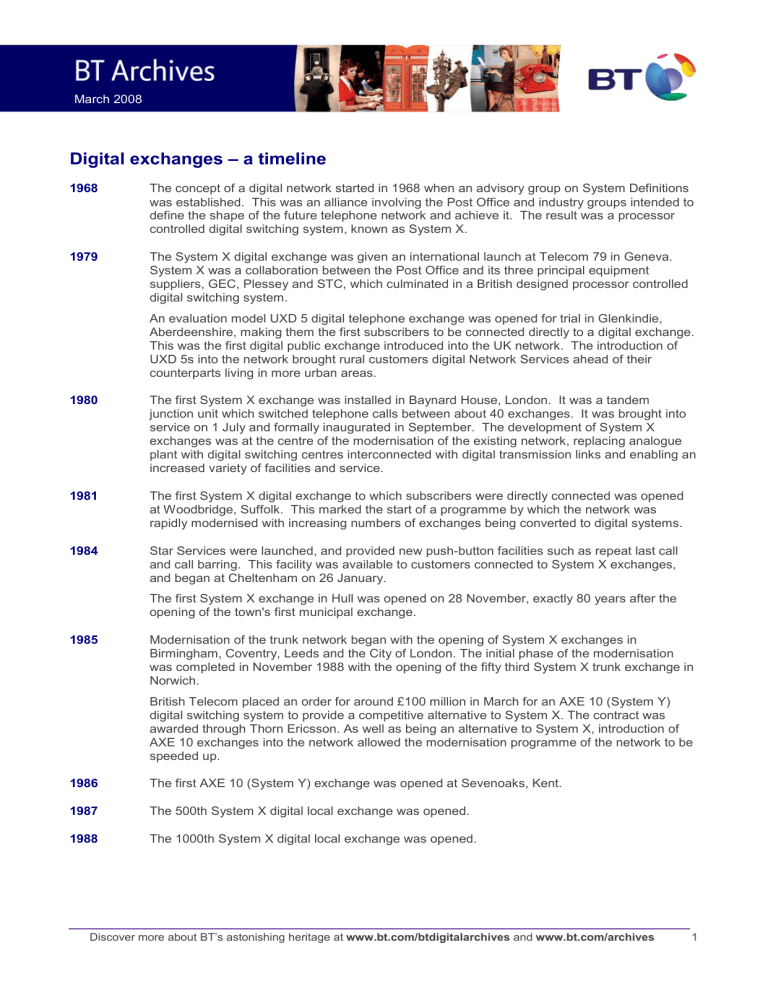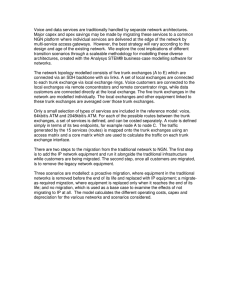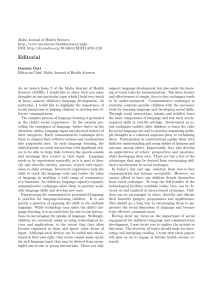Digital exchanges – a timeline

March 2008
Digital exchanges – a timeline
1968
1979
1980
1981
The concept of a digital network started in 1968 when an advisory group on System Definitions was established. This was an alliance involving the Post Office and industry groups intended to define the shape of the future telephone network and achieve it. The result was a processor controlled digital switching system, known as System X.
The System X digital exchange was given an international launch at Telecom 79 in Geneva.
System X was a collaboration between the Post Office and its three principal equipment suppliers, GEC, Plessey and STC, which culminated in a British designed processor controlled digital switching system.
An evaluation model UXD 5 digital telephone exchange was opened for trial in Glenkindie,
Aberdeenshire, making them the first subscribers to be connected directly to a digital exchange.
This was the first digital public exchange introduced into the UK network. The introduction of
UXD 5s into the network brought rural customers digital Network Services ahead of their counterparts living in more urban areas.
The first System X exchange was installed in Baynard House, London. It was a tandem junction unit which switched telephone calls between about 40 exchanges. It was brought into service on 1 July and formally inaugurated in September. The development of System X exchanges was at the centre of the modernisation of the existing network, replacing analogue plant with digital switching centres interconnected with digital transmission links and enabling an increased variety of facilities and service.
The first System X digital exchange to which subscribers were directly connected was opened at Woodbridge, Suffolk. This marked the start of a programme by which the network was rapidly modernised with increasing numbers of exchanges being converted to digital systems.
1984
1985
1986
1987
1988
Star Services were launched, and provided new push-button facilities such as repeat last call and call barring. This facility was available to customers connected to System X exchanges, and began at Cheltenham on 26 January.
The first System X exchange in Hull was opened on 28 November, exactly 80 years after the opening of the town's first municipal exchange.
Modernisation of the trunk network began with the opening of System X exchanges in
Birmingham, Coventry, Leeds and the City of London. The initial phase of the modernisation was completed in November 1988 with the opening of the fifty third System X trunk exchange in
Norwich.
British Telecom placed an order for around £100 million in March for an AXE 10 (System Y) digital switching system to provide a competitive alternative to System X. The contract was awarded through Thorn Ericsson. As well as being an alternative to System X, introduction of
AXE 10 exchanges into the network allowed the modernisation programme of the network to be speeded up.
The first AXE 10 (System Y) exchange was opened at Sevenoaks, Kent.
The 500th System X digital local exchange was opened.
The 1000th System X digital local exchange was opened.
Discover more about BT’s astonishing heritage at www.bt.com/btdigitalarchives and www.bt.com/archives 1
1989
1990
1994
1995
1998
A Worldwide Network Management Centre was opened in Oswestry, Shropshire on 5
September. The Centre monitored all of the System X exchanges and the company's three digital internal exchanges. The processors that controlled the exchanges sent data to the management floor at the Centre, providing continuously updated information on the number, destination and duration of calls made, providing an effective overview of the whole network.
Any potential trouble spots were highlighted on 25m long video walls, at that time the largest in
Europe, giving accurate information on how the network was performing.
The long-distance network became fully digital with the closure of the last analogue trunk exchange at Thurso, Scotland in July 1990.
The last TXK crossbar exchange was withdrawn at Droitwich, Worcestershire.
The last TXE2 exchanges at Ballycastle, Northern Ireland, Llandovery, Wales and Ramsbury,
Wiltshire were closed on 23 June.
The last Strowger exchanges at Crawford, Crawfordjohn and Elvanfoot, all in Scotland, were withdrawn on 23 June.
The last electromechanical switching system was withdrawn with the closure on 12 July of the relay-operated IAX (Island Automatic Exchange) on Foula, in the Shetland Isles.
The UK network became completely digital on 11 March with the conversion of the last electronic TXE4 exchange at Leigh-on-Sea, Essex to System Y (AXE 10) and that at Selby,
Yorkshire to System X. This was the culmination of a £29 billion investment by BT in modernise the exchange network.
Discover more about BT’s astonishing heritage at www.bt.com/btdigitalarchives and www.bt.com/archives 2





